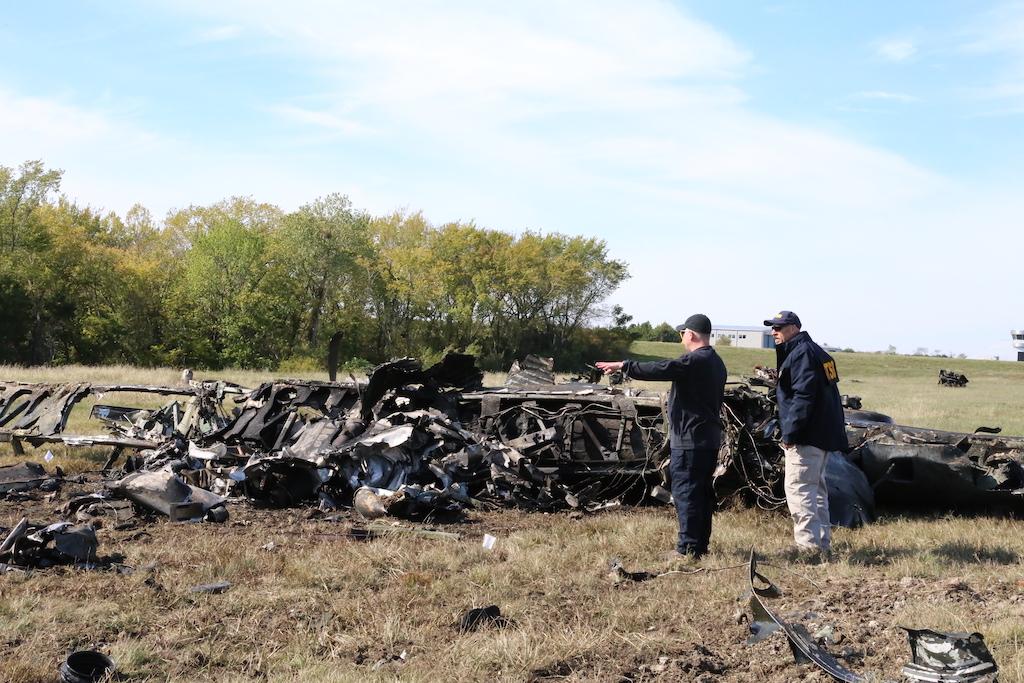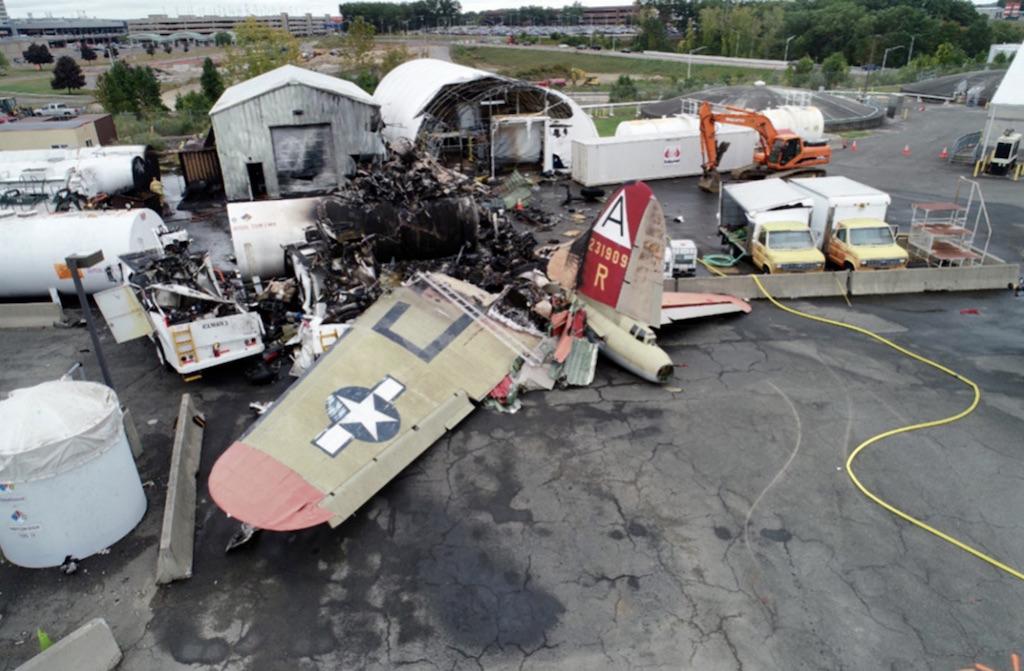
NTSB Investigator-in-Charge Jason Aguilera, left, and Board Member Michael Graham walk the accident scene of the Nov. 12 midair collision of a Boeing B-17G Flying Fortress and a Bell P-63F Kingcobra at Dallas Executive Airport.
Whenever I see a Boeing B-17 Flying Fortress at a museum or on static display at an airshow, I gaze in wonder at the aircraft that I believe played a pivotal role in World War II as well as in the science of aerial combat. Whenever I see the same aircraft flown at an airshow, and the sky peppered with other aircraft, I wonder how many are still flying and why we are risking a national treasure for the amusement of those watching. At last count, there are fewer than forty B-17s left in the country and fewer than a dozen of these are still in airworthy condition.
The midair collision in Dallas on Nov. 12 reduced our stock of irreplaceable warbirds by two. Was the loss of life and aircraft justified by the entertainment value of the airshow crowd? I don’t think so.
I’ve expressed these views to many of my peers over the years and the most common rejoinder is that aircraft are meant to fly, and we honor our history best by flying these historic aircraft. Perhaps. But each crash will mean there is one less aircraft to remind us aviators of where we came from and one less to inspire the next generation to continue our legacy. Much has been made about how well maintained these aircraft are, how highly trained the crews are and how tightly regulated the airshow industry has become. I will gladly cede the first point but not the second and third.
For a brief two-year span of my Air Force career, I flew airshows in Boeing 747s, designated E-4Bs, and got a close look at the “airshow circuit” at a few events. I will be the first to admit my vantage point was of an outsider looking in, not a real “airshow pilot.” I earned my airshow bona fides by sitting in the right seat watching our squadron’s top pilot go through the maneuvers on Day One of an airshow, and then he watched me give it a try on Day Two. When we were done, he signed me off and said, “You are now an airshow pilot.”
If you think I was undertrained, I agree. But I wasn’t alone. The Air Force at the time had but one truly professional aerial demonstration team, the Thunderbirds. The Air Force also had a few other pilots like me authorized to fly in airshows. Calling us the second string to the Thunderbirds would be giving us too much credit. I often thought of myself as an amateur airshow pilot.
A Full-Time Job

So, what is the difference between a professional aerial demonstration pilot and an amateur? Pilots who perform in the Thunderbirds and the Navy’s Blue Angels have long resumes of flying high-performance aircraft and have gone through a long selection process. They practice full time and I believe they log more hours in training than in front of airshow crowds. Everything they do is videoed and critiqued. The slightest mistakes are caught and corrected. What they are doing is a full-time job and can only be classified as hard work. For the rest of us, very little of that is true.
I doubt many airshow pilots are specially trained for flying their aircraft at high speeds and low altitudes, and certainly even fewer at flying in close formation. Even those who are military veterans are doubtless many years on from flying in a tightly regulated environment such as that found in a military fighter squadron. I think they are amateurs. Like me, even when I was an active-duty Air Force pilot, amateurs are not qualified to fly anything more than a simple takeoff and landing in front of an airshow crowd.
The second and perhaps even more dangerous part of this problem is the airshow organization itself. The best word to describe a Thunderbirds or Blue Angels airshow is choreography. In fact, it may be the highest form of choreography. You would be hard-pressed to find a Broadway show put on with equal precision. From what I’ve seen in my brief airshow experience and from what I’ve heard from some pilots on the airshow circuit today, much of what we see is made up on the spot. The “airshow boss” is often behind the scenes, directing traffic from a tersely written script with little more than a list of airplanes and times. It is more like a quarterback calling the plays at the line of scrimmage, but instead of athletes in heavy padding, we have aluminum aircraft traveling at high speeds with thin margins of error.
Many warbirds are privately owned, and you may argue that if the owners accept the risks, they are well within their rights to be amateur airshow pilots. I argue that owning a warbird carries with it a responsibility of preserving our aviation history and inspiring those who write history’s future chapters. Flying the aircraft is an honor and standing alongside such an aircraft on static display is the best way of sharing that honor.






Comments
However, if you are going to fly airshows too; it requires a professionally choreographed demonstration (as you well pointed out) with a rehearsal day prior to the event. If you just kick the tires and light the fire with a sketch of a plan; your going to get just what happened in Texas
Benrard Biales
Bernard Biales
“Much has been made about how well maintained these aircraft are, how highly trained the crews are and how tightly regulated the airshow industry has become. I will gladly cede the first point but not the second and third.”
That may be generous. The Connecticut crash of B-17 909 was due in part to inadequate maintenance. Ironically, the doomed aircraft commander in the crash was also the Director of Maintenance. Part of the problem is the lack of spare parts for a 70+ years old aircraft.
Those who want to see these warbirds fly are channeling Richard Bach’s guidance in “Illusions” - “Argue for your limitations, and sure enough they’re yours.” Col. Albright reminds us that emotion is a poor substitute for acknowledging those limitations, and then deciding whether the risks can be mitigated to an acceptable level. Two B-17s burning in three years says the answer is no.